Let’s face it—ecommerce discounts sell. They attract consumers and keep them coming back for more.
Interestingly, 60% of shoppers look for discounts or coupons to offset the prices of products. And over half of them say that discounts influence their purchase decisions.
It’s no surprise that all ecommerce brands, including behemoths like Amazon, roll out the discount carpet occasionally to attract buyers. It can help you boost purchases and win over the fence-sitters as well.
But launching sales and discounts all the time doesn’t help. It makes them ineffective. Also, the way you promote your discounts matters as it can make or break your campaign.
So, how can you get it all right?
We’ve got you covered with various ecommerce discounts marketing strategies. Let’s get started.
Why are discounts crucial for ecommerce, and what effect can you expect?
Today, there’s no debate about whether your brand should offer ecommerce discounts.
Discounts have been a key business element for years, and modern consumers still expect online stores to provide them with.
We’d say current customers are “hungry” for ecommerce discounts, coupons, and deals.
According to a study by Vericast, 60% of consumers are looking for more discounts to offset the high cost of products and services. It is also surprising to know that these coupons and discounts influence more than 50% of the buying decisions.
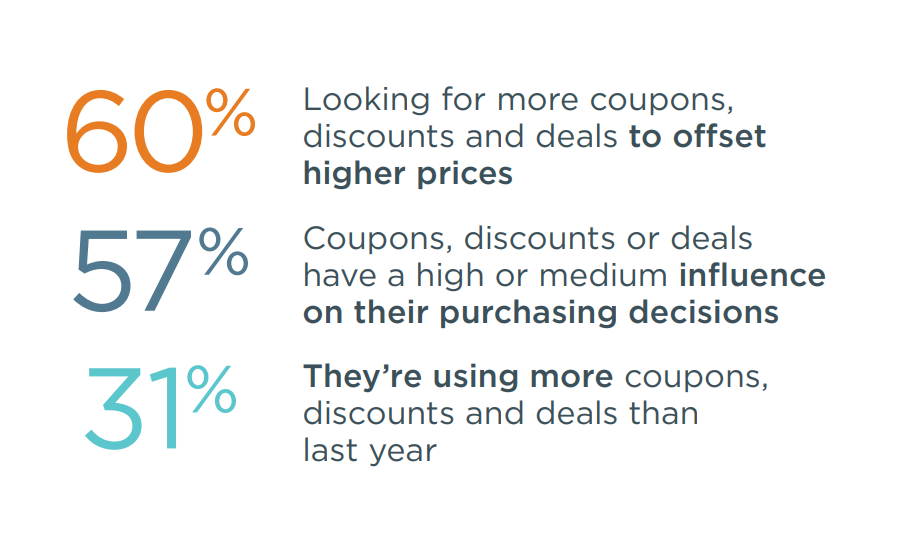
Source: Vericast
The study also found that 45% of shoppers are switching brands to cut costs. Additionally, 53% check out different stores to find the best price.

Source: Vericast
This research shows how essential product prices are to consumers. Today’s shoppers are looking for more value when purchasing online. As an online merchant, you can use ecommerce discounts to give shoppers more value for their money.
This will help you generate more sales since you’ll be able to attract customers from far and wide. But beyond increased sales, an effective ecommerce discount strategy offers other benefits such as:
- Increased conversions – Customers are more likely to buy with a discount. When customers see a discount, they see savings, increasing their chances of buying. This makes ecommerce discounts a great way to increase your conversions since not many people can resist the pull of a great offer.
- Boosts customer acquisition – Ecommerce discounts also help with customer acquisition. The lower your prices, the more customers will want to buy from your store. Practical strategies to attract new customers include flash sales, welcome discounts, and gifts for the first purchase.
- Improves customer loyalty and retention – Ecommerce discounts aren’t just for attracting new customers. Brands can also use personalized discounts and offers to reward their loyal customers.
10 most effective marketing strategies with ecommerce discounts
Let’s go over the top ecommerce discount types for online businesses.
1. Discount for the 1st purchase
Shoppers don’t always buy from an ecommerce store on their first visit. First-time visitors know very little about your brand and your products. As such, they may not feel confident buying the products in your store.
Your job is to nudge them in your direction and convince them to make a purchase. Offering them a discount is an excellent way to persuade visitors to buy from a new brand.
To succeed with this strategy, launch a popup on your website with a discount for the first purchase. Display the popup strategically so visitors don’t miss it as they browse your online store.
The popup should have a field where visitors can give their email addresses to receive the discount code. This strategy will also help you collect contacts for your email campaigns, another win.
When the visitor shares their email address, send them a welcome email with a discount code for their first purchase.
Rael uses this strategy to encourage shoppers to make their first purchase. They have given new customers a 10% discount on their first order.
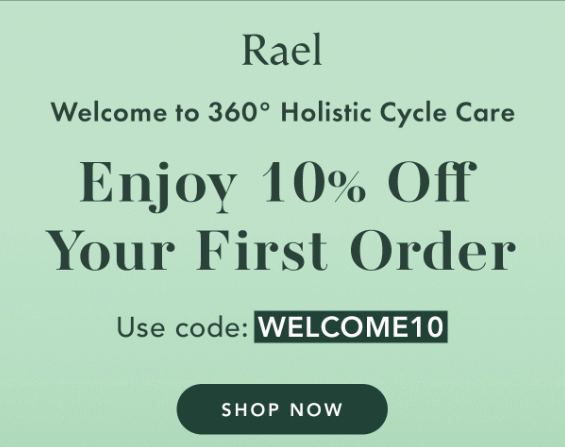
Source: Really Good Emails
To ensure this isn’t the last time the customer buys from your store, guarantee to provide them with the best services.
Since you have their email address, use it to build a thriving relationship with the customer. You can send them relevant recommendations, best-sellers, and custom offers based on their online behavior.
2. Discount to recover abandoned carts
According to Baymard Institute, the average documented cart abandonment rate is 70.19%. Many online shoppers are adding items to their carts but leave without finishing their order, much to the disappointment of online merchants.
The top reason for shoppers to abandon their cart is extra hidden costs. Baynard’s research concluded that 48% of customers abandoned their carts because of additional charges such as shipping and tax.

Source: Baymard Institute
You can offer them a discount to get these shoppers to return to your store and finish their order. The discount slashes the product’s total cost and makes up for the additional fees, such as shipping and taxes.
Ecommerce discounts for abandoned carts are a powerful strategy for improving sales. This is because you are reaching users who have already shown interest in your products.
A recent Omnisend study found that 39.7% of users who clicked an abandoned cart email finished their purchase.
Launch an automated cart recovery campaign of two or three emails to use this strategy effectively. The first email is a simple reminder about the abandoned cart. The third email shares a discount to seal the deal.
In the example below, Society6 gives the shopper a 30% discount to motivate them to complete their order (usually brands offer 5-10% off). The discount expires in 48 hours to create a sense of urgency.
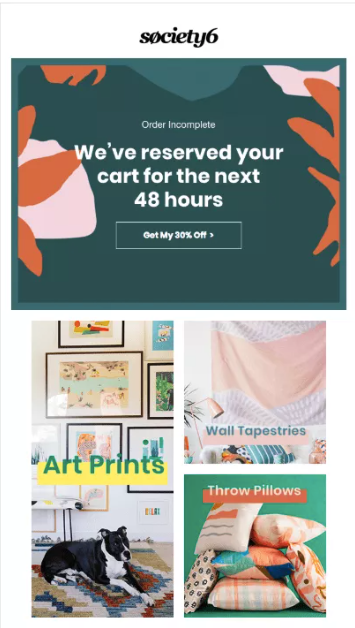
Source: Omnisend
3. Volume discounts
Volume discounts are an effective way to encourage shoppers to buy more products from your store. Each item typically costs less when a customer buys them in bulk.
For example, a clothing store can sell one t-shirt for $10 but offer five for $40 and ten for $75. In this case, one t-shirt costs $8 when you buy five at a go and $7.5 when you buy ten of them.
And customers looking to discover value when shopping need help to resist volume discounts.
Ecommerce brands can implement volume discounts in two ways:
- Non-cumulative volume discounts – Merchants offer this discount on one order. For example, a brand can have a buy 2 get 10% off, buy 3 get 15% off, buy 4 get 20% off offer. The purpose is to encourage shoppers to place high-volume orders.
- Cumulative volume discounts – Merchants offer this discount on all orders over a certain period. The aim is to encourage repeat purchases.
Amazon regularly uses volume discounts to get shoppers to buy more products. In the example below, you can buy a pack of 2 t-shirts for $19. This means one t-shirt costs $9.50 when you buy a pack of 2.
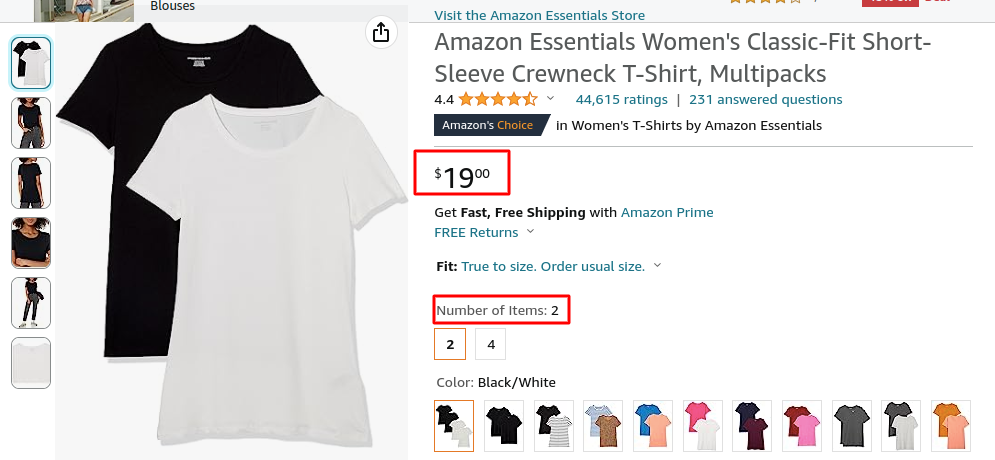
Source: Amazon
Amazon also offers the same t-shirts as a pack of 4 for $28.50. In this case, one T-shirt costs $7.125. As such, the shopper gets a discount of more than $2 per shirt when they purchase in bulk.

Source: Amazon
You can also combine volume discounts with occasional campaigns. For example, during the holiday shopping season, you can encourage customers to buy more by offering a volume discount for your products.
4. Occasion-based campaigns
Seasonal ecommerce discounts are great for attracting customers with time-limited offers. Online merchants use these promotions to move products that can quickly become seasonally redundant and make room for new inventory.
Take Fitbit’s Valentine’s Day sale, for example. Since the occasion is very short, the brand offers up to $60 off its trackers.
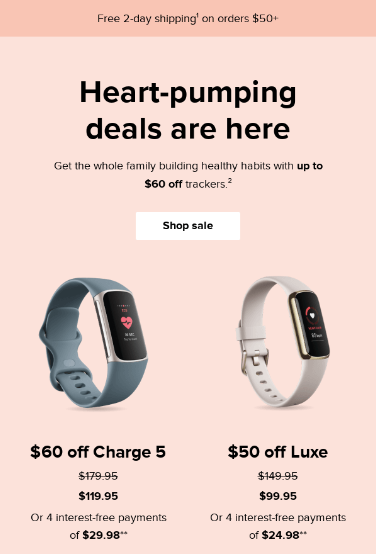
Source: Really Good Emails
But seasonal ecommerce discounts aren’t just for clearing seasonal stock. They are also perfect for driving sales during special occasions throughout the year.
Other instances that give you a chance to run occasion-based campaigns include:
- Single’s Day on 11 – 11: 11% off your products and services
- Valentine’s Day: 14% off your products
- Mother’s Day: 20% off Mother’s Day gifts
- Father’s Day: 20% off all Father’s Day gifts
These campaigns can be site-wide or department-specific. For example, you can have a discount of 20% off all shoes or 30% off women’s dresses on Mother’s Day.
Kipling had a fantastic site-wide campaign to celebrate Single’s Day. They combined volume ecommerce discounts and occasion-based campaigns to offer customers up to 33% off all their products.

Source: Mail Designer
5. Birthday/anniversary email with individual discounts
Ecommerce discounts allow you to show customers you value them. Case in point: you can send a special offer for customers on special days such as their birthdays or anniversaries.
Customers will likely take advantage of exclusive deals because they make them feel special.
To drive sales for your business with this strategy, send your customers a targeted email with a special offer just for them. You can also send relevant recommendations to the recipient based on their past activity in your store.
With such offers, you want to make them time-limited to get the customer to act quickly. In the example below, Kawaii Slime gives the recipient 20% off their entire order on their birthday.
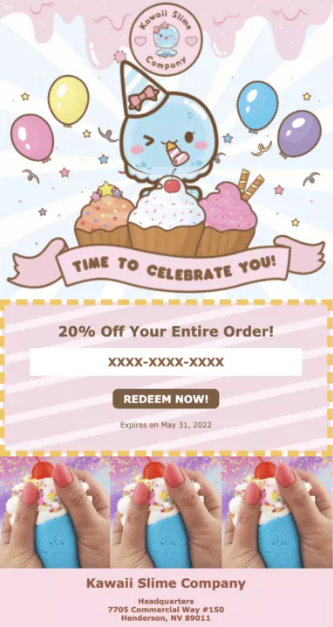
Source: Omnisend
The offer is also time-limited; the recipient must buy a product by May 31 to enjoy the discount.
6. Flash sales
Flash sales are perfect for improving conversions and sales. These short-term ecommerce discounts can help you motivate shoppers to impulse buy your products. They may even help you convince customers to check out other non-sale items in your store.
According to Statista, holiday ecommerce sales hit a new record in 2023. Towards the year’s end, US online shoppers spent $253.71 billion. This marked an increase from $227.96 billion in 2022.
As we get to the holidays, consumers are pressured to spend because of the gift-giving culture. By offering ecommerce discounts, you can connect emotionally with holiday shoppers and drive traffic to your store.
This is a strategy that Macy’s often uses to drive sales. Currently, they have a flash sale for 50–70% off on shoes and accessories.
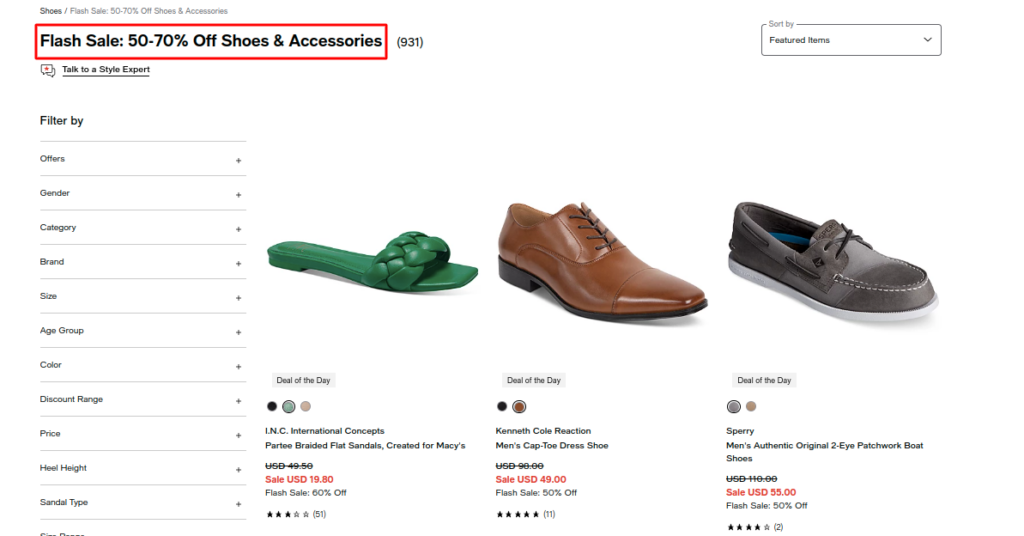
Source: Macy’s
A shoe that usually costs $98 now retails for $49. This is a good deal that allows those who act fast to get quality products at a lower price.
Thanks to the FOMO effect, most shoppers will jump on such deals since they don’t want to miss out on such an offer. Even if they had not planned to buy shoes, 50% off is a great deal to turn down.
Flash sales also use urgency to drive sales. The offers only run for a short time, so shoppers have to act quickly to enjoy the massive ecommerce discounts.
One thing to remember with flash sales isn’t to overdo them. One or two times per year is fine. For instance, you can have your first sale at the beginning of summer and the second one during Black Friday.
Flash sales that happen too frequently can harm your bottom line. This is because they can signal customers not to buy from your store until the next promotion.
Before starting a promotion, define clearly what you want to achieve. The goals for your flash sale could be:
- Attracting new customers
- Boosting customer loyalty
- Stock clearance
- Showing new products
Also, try to create a sense of urgency to get customers to act fast. With flash sales, the shorter the promotion, the better.
7. Free shipping
Most shoppers want brands to offer them free shipping as an ecommerce discount. Customers feel that shipping costs make a product more expensive. You can motivate shoppers to buy more by offering them free shipping.
But let’s be honest: free shipping isn’t a sustainable business strategy. Shipping costs can get so expensive, and this will eat into your profits.
That’s why you want to be strategic with this plan and only offer free shipping when customers meet certain thresholds. For example, you can ask customers to spend more than a certain amount or order a certain number of items from your store to unlock free shipping.
Hint provides free shipping, but customers must buy more than three cases of their flavored water to unlock the feature.
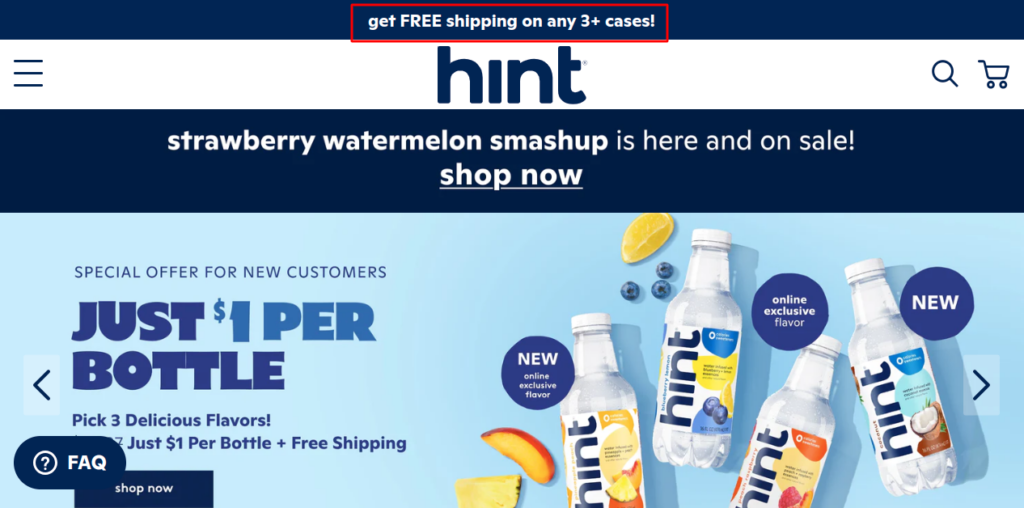
Source: Hint
You can also combine free shipping with other ecommerce discounts discussed in this post. For example, you can give volume discounts to those who buy in bulk and add free shipping to sweeten the deal.
Kipling combines discounts for the first order and free shipping to motivate visitors to complete their first purchase.
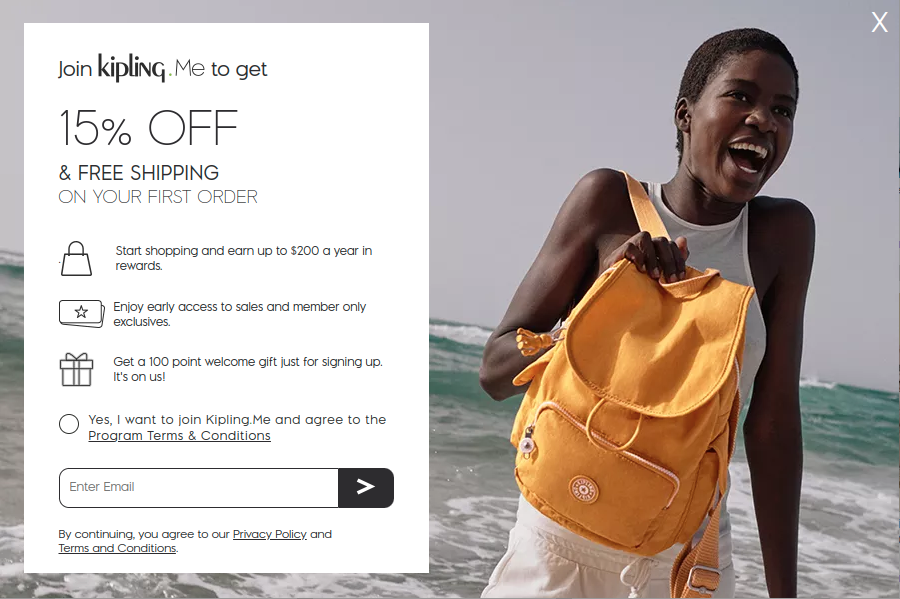
Source: Kipling
8. Reward loyal customers
Increasing the number of repeat customers is an excellent strategy for growing your ecommerce business. A small group of customers who buy from your store repeatedly can generate a lot of sales for your business without incurring huge acquisition costs.
Customer acquisition costs have also increased sharply, forcing brands to revamp their customer retention efforts.
With targeted ecommerce discounts, you can convince current customers to return to your online store for another purchase. Discounts are a way to show your loyal customers you appreciate and value them.
For instance, you can create a post-purchase workflow, and for every 3rd, 4th, or 5th purchase, you send a thank you note with a discount for the next purchase.
Your favorite customers will appreciate your kindness and return to your store when they need to buy another product.
Another way to reward your loyal customers is with a reward program. Starbucks Rewards is an excellent example of building a loyal client list and rewarding them for staying faithful to the brand.
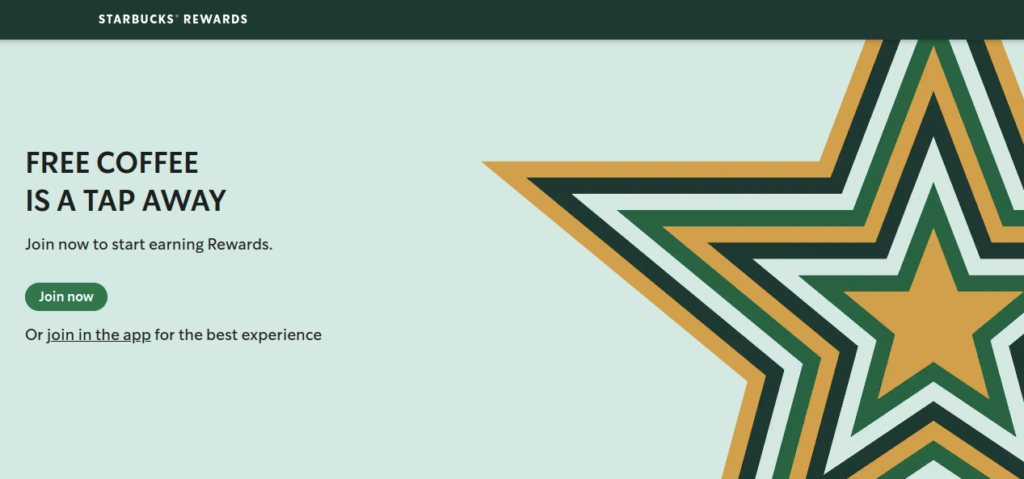
Source: Starbucks
Starbucks Rewards members earn points when they order and pay for their products. They can then redeem their points for free food and drinks at a Starbucks store.
A reward scheme like this is a great way to build a community of loyal customers. The customers will want to earn as many points as possible to make a reward, which will keep them loyal to your brand.
9. Pre-order discounts
Pre-order discounts are ecommerce discounts merchants can use to maximize sales for a new product. When you launch a new product, you can promote it with a pre-order discount and get customers excited to buy it.
Besides creating a buzz for a new product, you can use pre-order ecommerce discounts to achieve the following:
- Drive organic traffic to your site – Interested shoppers have to visit your site to pre-order the product. This organic traffic bears a lot of valuable insights like the age, gender, and location of your passionate customers. You will then use this information to improve their products and marketing campaigns.
- Helps you offset production costs – You can easily run out of funds when developing a new product. Offering pre-order discounts allows you to get funds from your customers that you’ll use to clear your bills.
- Helps you gauge the demand for your products – High pre-order volumes mean your upcoming product is popular with the masses. But if the numbers are low, it could mean you’ve not promoted the new product well.
The example below shows a pre-order discount for a watch that’s about to launch. The brand gives customers 50% off for pre-ordering. However, the offer is time-limited and interested users need to act quickly and pre-order the watch.
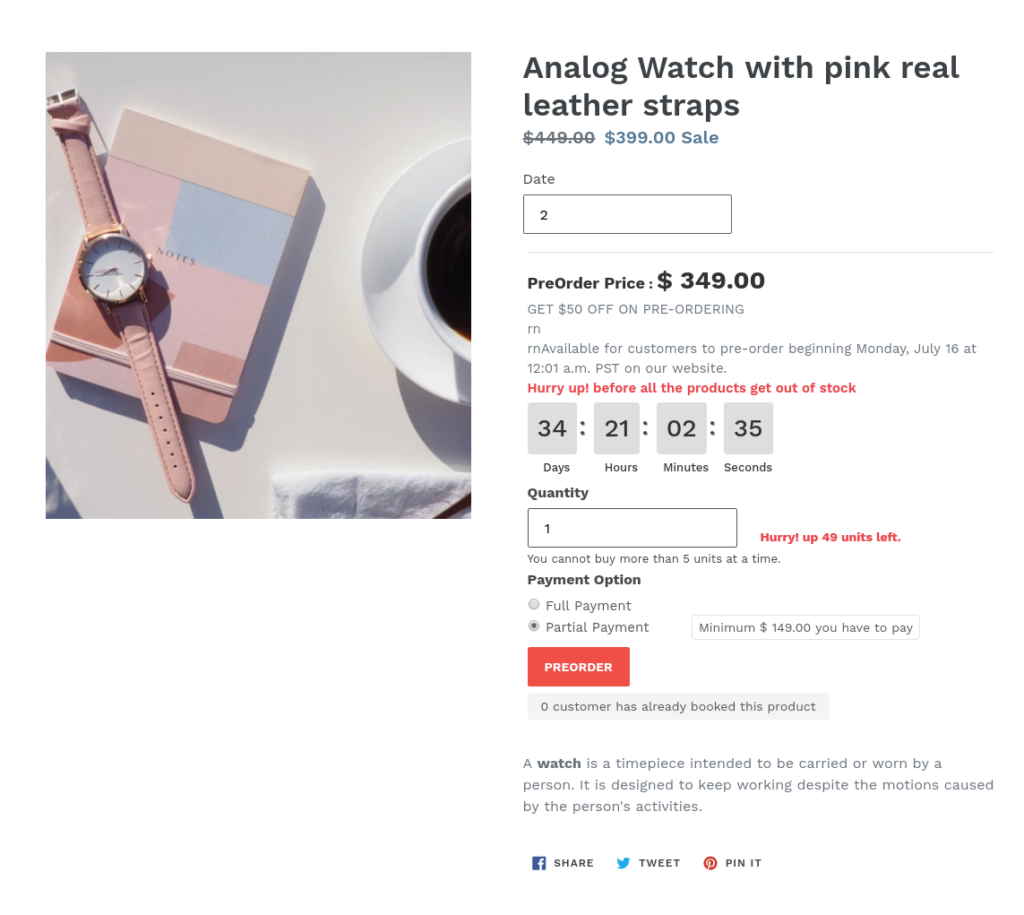
Source: Webkul
Creating a sense of urgency is a great way to drive users into action with your pre-order discounts. Set a deadline for your pre-order discounts to get interested shoppers to act now.
Also, don’t offer a large pre-order discount for your new products so as not to eat too much into your profits. Find the right balance to keep your business competitive while attracting customers with affordable pricing.
10. Giving a gift
Lastly, consider giving gifts to those who buy a certain product or spend a certain amount of money. Shoppers are keen to get as much value as possible and a gift could be what you need to get them to buy.
You can use this tactic with your new customers to get them to complete their first purchase. You can also use it with your loyal customers as a way to appreciate them for their continued support.
Philosophy gives customers a free gift when they spend more than $35 in the store. The gift has a value of $33, meaning customers are getting almost 100% more value for orders above $35.
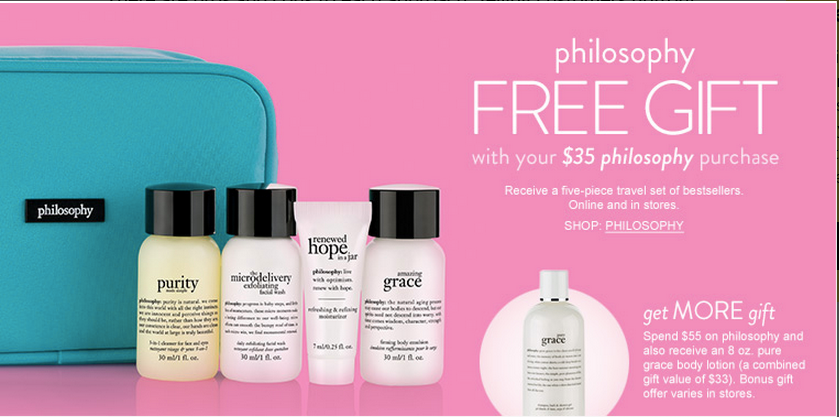
Source: Ecwid
When designing your gifting strategy, there are two options to consider. You can be explicit and inform shoppers what they’ll get when they meet the set conditions. Alternatively, you can let the gift be a surprise.
Revealing the gift to customers before they shop may convince them to place an order, especially if they see the value of the gift. However, it also robs them of the delight of receiving a surprise gift.
In this case, your choice depends on what you want to achieve:
- Reveal the free gift to customers if you want to use it as an incentive to drive them to place an order. This is the strategy Philosophy used in the example above.
- Choose a surprise gift if you want to delight your customers and boost word-of-mouth marketing on social media.
Best digital marketing ways to offer your discounts
Here are the most effective ways to offer ecommerce discounts to your customers.
-
Popup or other signup form asking for email address
Popups are perfect for offering ecommerce discounts to your store visitors. When timed correctly, popups with signup forms will help you grow your email subscriber list. They’ll also help you boost sales by offering customers a discount to shop in your store.
Gap uses popups with a discount to encourage visitors to subscribe to their list. They give users 25% off and access to exclusive offers when they sign up for their email list.
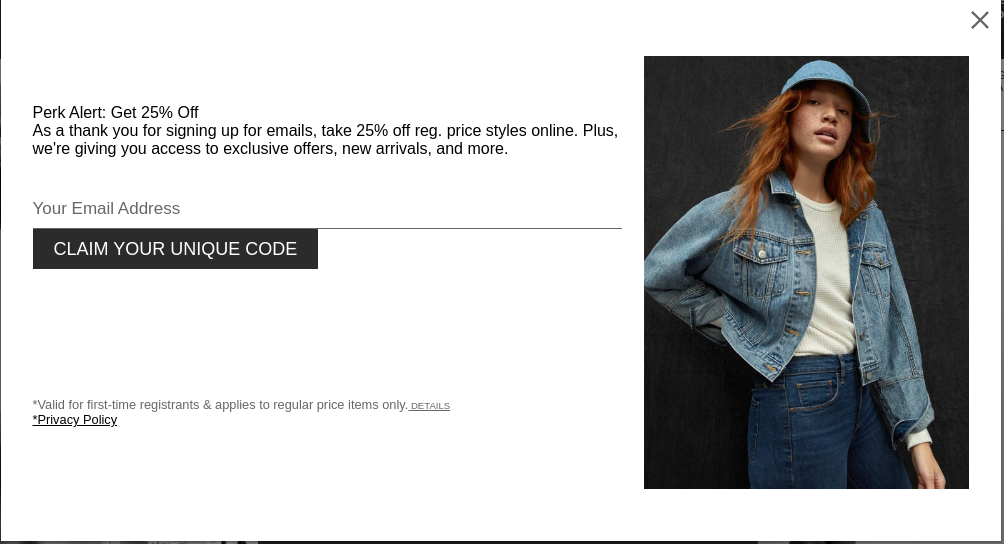
Source: Gap
When using popups to collect email addresses, you want to be very strategic with your placement.
- Only display the popup to users who haven’t subscribed to your email list
- Show popups to specific people, such as those who visit specific pages on your store
- Schedule the start and end times appropriately so as not to disrupt the visitor’s browsing experience
2. Simple popup with a limited-time offer
To get customers to act fast, send them an exclusive offer that expires in a short time. Time-limited offers create a sense of urgency and are what you need to convince hesitant shoppers to complete their orders.
The example below shows a popup with a membership discount and offer for free shipping for orders above $100. However, the reward is valid for a limited time and interested users need to act fast to claim it.
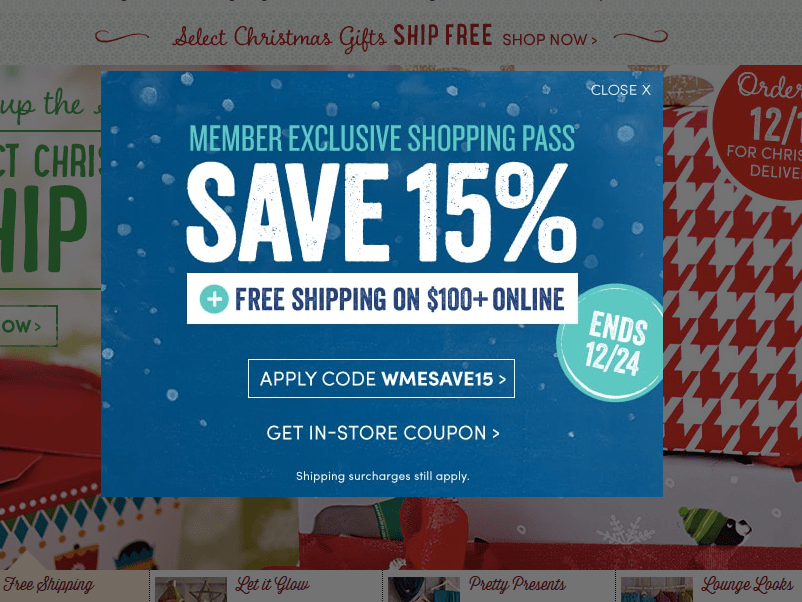
Source: Pinterest
3. Social media posts
You can also share your ecommerce discounts through social media posts. Find the popular platforms with your target audience and publish a post with exclusive discounts.
You can also use social media ads to increase your reach and target the right users.
4. Checkout notification
Are shoppers taking too long to complete their purchases?
Send them a notification on the checkout page with a small discount for their order. You could need this to reduce your cart abandonment rate and prevent shoppers from checking out the competition.
5. Regular email campaign
You can also use your regular email campaigns to share ecommerce discounts with your customers. As you share the latest updates in your email newsletter, you can throw in a discount code to drive customers to your site.
In the example below, P & Co. invites users to participate in a flash sale through its regular email campaigns.

Source: Really Good Emails
The flash sale only runs for the weekend, so interested users have to act fast to enjoy the 20% discount.
6. Marketing automation
Marketing automation is another effective tool for giving ecommerce discounts. It helps you save time and engage users with targeted messaging.
You can create a workflow to welcome new subscribers and give them a discount for their first purchase. The example below shows how B-wear uses marketing automation to engage new email subscribers.
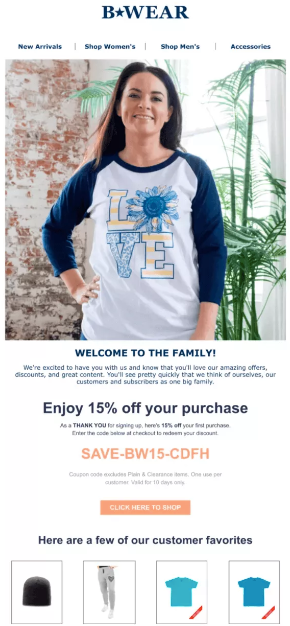
Source: Omnisend
The brand welcomes new subscribers with a 15% discount and shares the top picks by customers.
Besides welcome emails, you can also use marketing automation to activate lapsed purchases with exclusive discounts. Additionally, you can use it for your abandoned cart campaigns and many other cases.
Challenges you might face when using discounts
Whether you’re launching a new online store or growing an existing ecommerce business, offering discounts is non-negotiable. However, before you take the plunge, you should be aware of the downsides.
1. Profit margin erosion
Offering too many discounts too often reduces the revenue generated per order and eats away at your profits. It’s particularly true when you use discounts as the primary driver for attracting and converting customers.
Plus, you’ll have to set aside a marketing budget to promote these offers. It skyrockets customer acquisition costs and takes a further toll on profitability. You should find the right balance between discounts and regular pricing to ensure your revenue and profit keep increasing.
2. Brand perception
Frequent discounts and promotions can undermine your brand image and reputation. Customers might perceive your brand as budget-oriented, which, in turn, can affect its positioning. Worse still, it can lead them to question your product’s credibility and reliability. It can be particularly detrimental if you want to build a premium brand. In such a case, you should use discounts sparingly.
3. Overdependence on sales
When you run promotional offers and discounts regularly, customers may become reluctant to buy products at full price. They’d rather wait for the next offer, which they know is just around the corner.
It can disrupt your sales cycles, leading to fluctuations in revenue and cash flow issues. Also, it makes sales forecasting and long-term planning more difficult. It could also lead to a situation where you’ll have to regularly launch promotions to keep sales trickling in.
4. Competitive response
You might prompt competitors to launch their own promotional offers if you offer too many discounts. It can trigger a price war, where each brand tries to entice customers with bigger discounts. In such a scenario, you’ll be left with no choice but to bring out more offers, eroding your profit margins further.
5. Loss of trust
While you may have a bunch of loyal customers, there may be many who’d be sitting on the fence for numerous reasons. While launching discounts might help you convert a few of those due to the pricing drop, there may be others who might get alienated from the brand. They may feel that the product prices are inflated during regular times if you’re selling them at a steep discount during promotions. It could lead to trust issues.
Wrap up
Incentivizing your customers is an effective way to boost sales. Customers are keen to get value for their money. As such, you can use ecommerce discounts to increase the value of your products or services.
Try out the ecommerce discount types highlighted above to find out what works for your business. Once you gather enough data about your customer behavior, you can offer the right discounts to grow your business.
